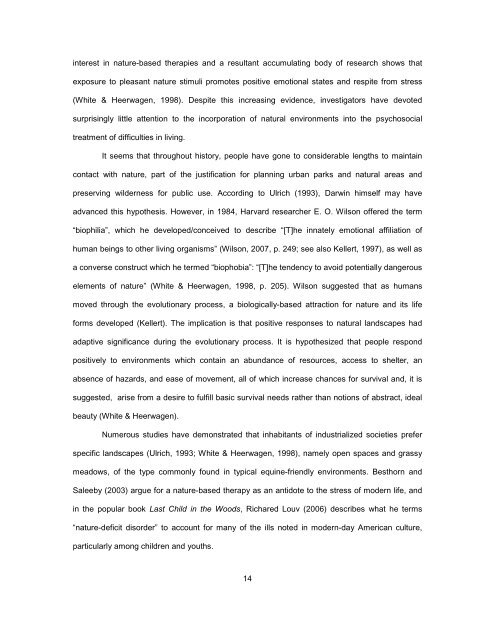A SYSTEMATIC REVIEW OF THE EFFECTS OF PSYCHOTHERAPY ...
A SYSTEMATIC REVIEW OF THE EFFECTS OF PSYCHOTHERAPY ...
A SYSTEMATIC REVIEW OF THE EFFECTS OF PSYCHOTHERAPY ...
You also want an ePaper? Increase the reach of your titles
YUMPU automatically turns print PDFs into web optimized ePapers that Google loves.
interest in nature-based therapies and a resultant accumulating body of research shows that<br />
exposure to pleasant nature stimuli promotes positive emotional states and respite from stress<br />
(White & Heerwagen, 1998). Despite this increasing evidence, investigators have devoted<br />
surprisingly little attention to the incorporation of natural environments into the psychosocial<br />
treatment of difficulties in living.<br />
It seems that throughout history, people have gone to considerable lengths to maintain<br />
contact with nature, part of the justification for planning urban parks and natural areas and<br />
preserving wilderness for public use. According to Ulrich (1993), Darwin himself may have<br />
advanced this hypothesis. However, in 1984, Harvard researcher E. O. Wilson offered the term<br />
“biophilia”, which he developed/conceived to describe “[T]he innately emotional affiliation of<br />
human beings to other living organisms” (Wilson, 2007, p. 249; see also Kellert, 1997), as well as<br />
a converse construct which he termed “biophobia”: “[T]he tendency to avoid potentially dangerous<br />
elements of nature” (White & Heerwagen, 1998, p. 205). Wilson suggested that as humans<br />
moved through the evolutionary process, a biologically-based attraction for nature and its life<br />
forms developed (Kellert). The implication is that positive responses to natural landscapes had<br />
adaptive significance during the evolutionary process. It is hypothesized that people respond<br />
positively to environments which contain an abundance of resources, access to shelter, an<br />
absence of hazards, and ease of movement, all of which increase chances for survival and, it is<br />
suggested, arise from a desire to fulfill basic survival needs rather than notions of abstract, ideal<br />
beauty (White & Heerwagen).<br />
Numerous studies have demonstrated that inhabitants of industrialized societies prefer<br />
specific landscapes (Ulrich, 1993; White & Heerwagen, 1998), namely open spaces and grassy<br />
meadows, of the type commonly found in typical equine-friendly environments. Besthorn and<br />
Saleeby (2003) argue for a nature-based therapy as an antidote to the stress of modern life, and<br />
in the popular book Last Child in the Woods, Richared Louv (2006) describes what he terms<br />
“nature-deficit disorder” to account for many of the ills noted in modern-day American culture,<br />
particularly among children and youths.<br />
14
















